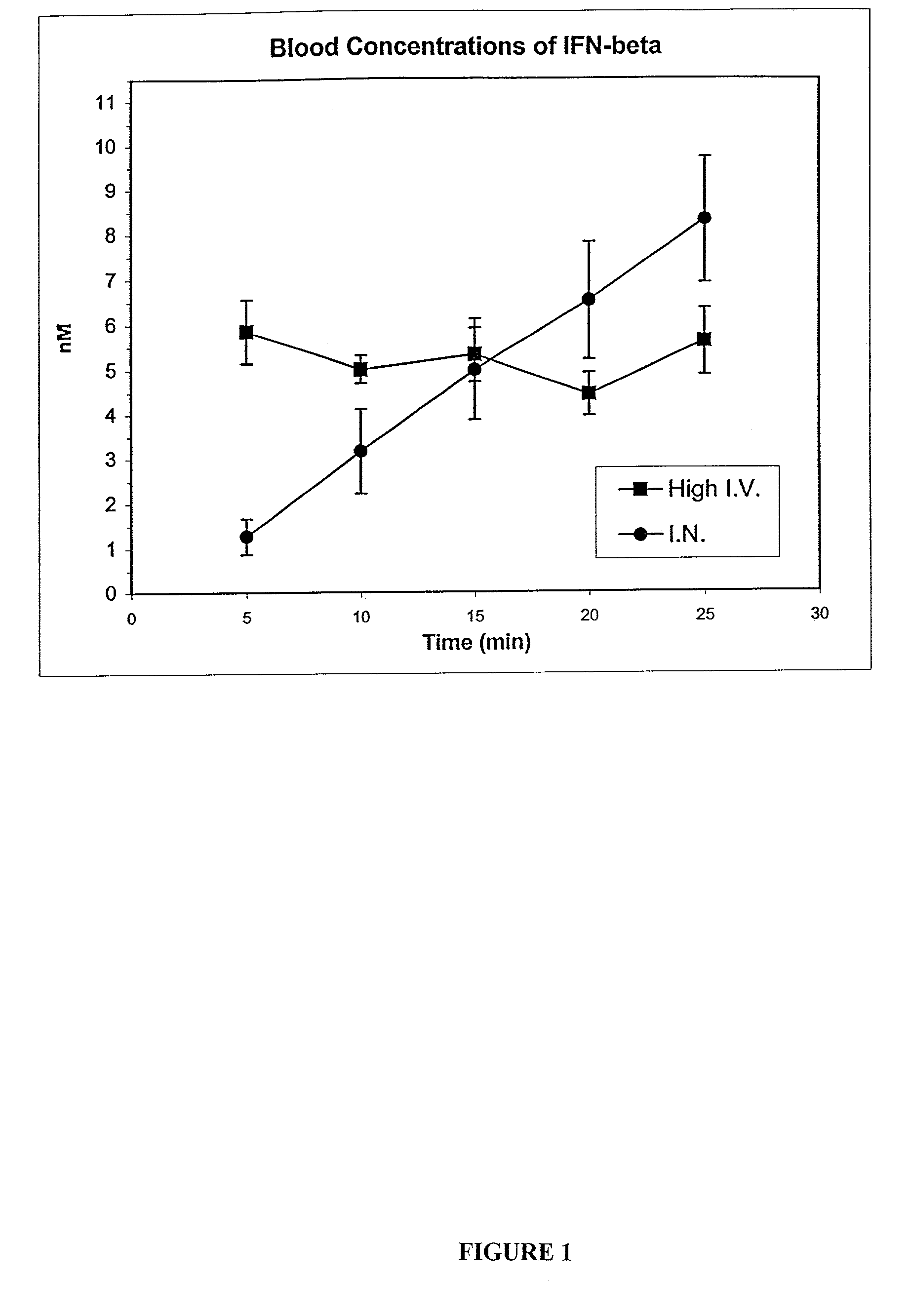Method for administering a cytokine to the central nervous system and the lymphatic system
a technology of central nervous system and lymphatic system, applied in the direction of peptide sources, immunological disorders, metabolism disorders, etc., can solve the problems of inability to administer the desired therapeutic agent to the cns, the current method of delivering desired therapeutic agents is typically invasive, and the injection is, however, impractical for most medications, so as to achieve the effect of modulating an immune or inflammatory respons
- Summary
- Abstract
- Description
- Claims
- Application Information
AI Technical Summary
Benefits of technology
Problems solved by technology
Method used
Image
Examples
example 1
Intranasal Administration of IFN-β to the CNS Introduction
[0172]Administering interferon-β (IFN-β) intranasally is an effective means for delivering this cytokine to the CNS of an animal.
Materials and Methods
[0173]Intranasal Delivery to the CNS
[0174]Male Sprague-Dawley rats, 199 and 275 grams, were anesthetized with intraperitoneal pentobarbital (40 mg / kg). Drug delivery to the CNS was assessed after intranasal administration of 51 picomoles and 57 picomoles of 125I-IFN-β in 20 mM Hepes, pH 7.5, to the light and heavy rat, respectively. Rats were placed on their backs and administered ˜100 microliters 125I-IFN-β to each naris over 10–22 minutes, alternating drops every 2–3 minutes between the left and right nares. During the intranasal administration of IFN-β, one side of the nose and the mouth were held closed. This method of administering the cytokine allows for both pressure and gravity to deliver the agent into the upper one third of the nasal cavity. Rats subsequently underwent...
example 2
Intranasal Administration of IFN-D Retains Pharmacological Activity in the CNS
[0181]Assays were performed to determine if IFN-β, delivered intranasally, retained pharmacological activity in the CNS. IFN-β activates signal transduction pathways via a cell surface IFN receptor. The IFN receptor is part of a prototypical JAK-STAT signaling complex. It has two transmembrane chains that associate with intracellular signaling proteins including TYK2, JAK1, and two latent transcription factors termed “signal transducers and activators of transcription” (STATs). Binding of IFN-β to the receptor brings the two Janus kinases (TYK2 and JAK1) near each other, and they become activated by phosphorylation. The kinases then activate the cytoplasmic tails of the IFN receptors by phosphorylating tyrosine residues. These phosphotyrosines provide docking sites for the STATs, bringing them into appropriate positions for phosphorylation by the nearby Janus kinases. Upon phosphorylation STATs translocate...
example 3
Intranasal Administration of IFN-D to the Lymphatic System
[0186]Intranasal delivery of [125I] BETASERON® was performed in Sprague-Dawley Rats as essentially described in Example 1. 3.9–7.9 nmol BETASERON® was administered in a 44–96 μl volume over the course of 20–29 minutes. Animals were perfused at 30 minutes. Data obtained from eight individual animals is provided in Table 3. Experimental means from this set of experiments are provided in Table 4. These quantitative studies demonstrated delivery of [1251] BETASERON® to the superficial cervical nodes and to the deep cervical nodes of the lymphatic system. On average, 6.1 nM BETASERON® was found in the superficial cervical nodes, and 31.5 nM was found in the deep cervical nodes following the administration methods of the invention. These results are summarized in Table 5.
[0187]
TABLE 3Betaseron Concentration (nM) FollowingI.N. Administration of 125I-IFNβ + rhIFNβExperimentIF34IF36IF37IF38MicroCi31476148Nmol3.96.97.96.6Blood Sample #...
PUM
| Property | Measurement | Unit |
|---|---|---|
| total volume | aaaaa | aaaaa |
| pH | aaaaa | aaaaa |
| pH | aaaaa | aaaaa |
Abstract
Description
Claims
Application Information
 Login to View More
Login to View More - R&D
- Intellectual Property
- Life Sciences
- Materials
- Tech Scout
- Unparalleled Data Quality
- Higher Quality Content
- 60% Fewer Hallucinations
Browse by: Latest US Patents, China's latest patents, Technical Efficacy Thesaurus, Application Domain, Technology Topic, Popular Technical Reports.
© 2025 PatSnap. All rights reserved.Legal|Privacy policy|Modern Slavery Act Transparency Statement|Sitemap|About US| Contact US: help@patsnap.com

